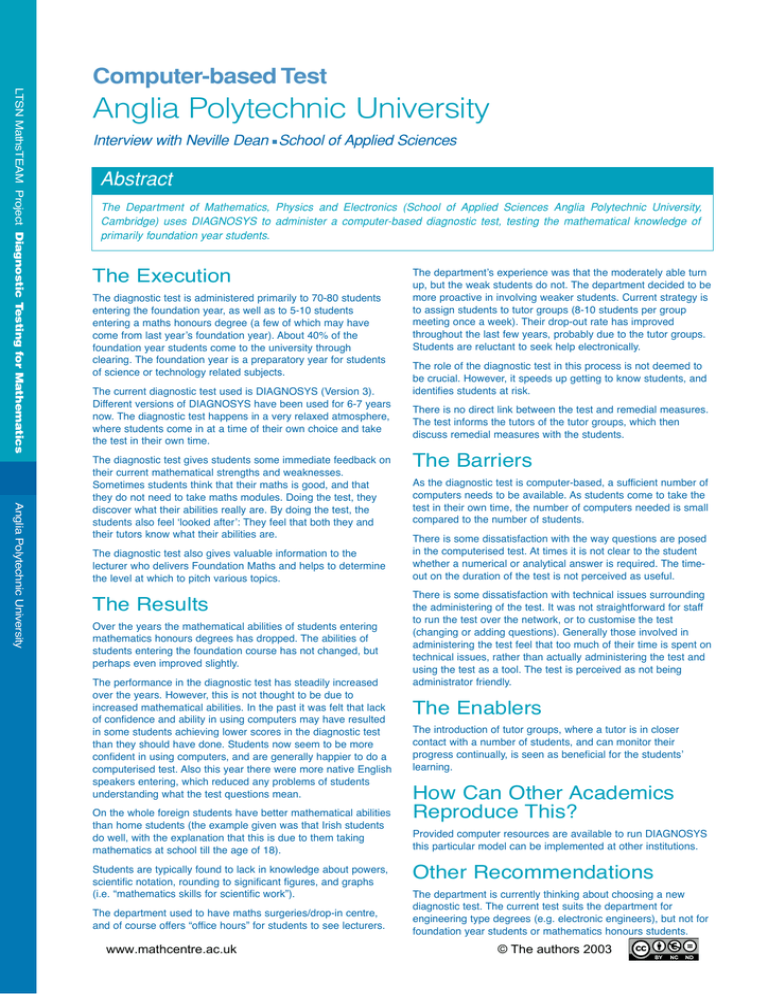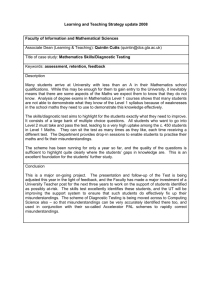Anglia Polytechnic University Computer-based Test Abstract Interview with Neville Dean
advertisement

Computer-based Test LTSN MathsTEAM Project Diagnostic Testing for Mathematics Anglia Polytechnic University Interview with Neville Dean ■ School of Applied Sciences Abstract The Department of Mathematics, Physics and Electronics (School of Applied Sciences Anglia Polytechnic University, Cambridge) uses DIAGNOSYS to administer a computer-based diagnostic test, testing the mathematical knowledge of primarily foundation year students. The Execution The diagnostic test is administered primarily to 70-80 students entering the foundation year, as well as to 5-10 students entering a maths honours degree (a few of which may have come from last year’s foundation year). About 40% of the foundation year students come to the university through clearing. The foundation year is a preparatory year for students of science or technology related subjects. The current diagnostic test used is DIAGNOSYS (Version 3). Different versions of DIAGNOSYS have been used for 6-7 years now. The diagnostic test happens in a very relaxed atmosphere, where students come in at a time of their own choice and take the test in their own time. Anglia Polytechnic University The diagnostic test gives students some immediate feedback on their current mathematical strengths and weaknesses. Sometimes students think that their maths is good, and that they do not need to take maths modules. Doing the test, they discover what their abilities really are. By doing the test, the students also feel ‘looked after’: They feel that both they and their tutors know what their abilities are. The diagnostic test also gives valuable information to the lecturer who delivers Foundation Maths and helps to determine the level at which to pitch various topics. The Results Over the years the mathematical abilities of students entering mathematics honours degrees has dropped. The abilities of students entering the foundation course has not changed, but perhaps even improved slightly. The performance in the diagnostic test has steadily increased over the years. However, this is not thought to be due to increased mathematical abilities. In the past it was felt that lack of confidence and ability in using computers may have resulted in some students achieving lower scores in the diagnostic test than they should have done. Students now seem to be more confident in using computers, and are generally happier to do a computerised test. Also this year there were more native English speakers entering, which reduced any problems of students understanding what the test questions mean. On the whole foreign students have better mathematical abilities than home students (the example given was that Irish students do well, with the explanation that this is due to them taking mathematics at school till the age of 18). Students are typically found to lack in knowledge about powers, scientific notation, rounding to significant figures, and graphs (i.e. “mathematics skills for scientific work”). The department used to have maths surgeries/drop-in centre, and of course offers “office hours” for students to see lecturers. www.mathcentre.ac.uk The department’s experience was that the moderately able turn up, but the weak students do not. The department decided to be more proactive in involving weaker students. Current strategy is to assign students to tutor groups (8-10 students per group meeting once a week). Their drop-out rate has improved throughout the last few years, probably due to the tutor groups. Students are reluctant to seek help electronically. The role of the diagnostic test in this process is not deemed to be crucial. However, it speeds up getting to know students, and identifies students at risk. There is no direct link between the test and remedial measures. The test informs the tutors of the tutor groups, which then discuss remedial measures with the students. The Barriers As the diagnostic test is computer-based, a sufficient number of computers needs to be available. As students come to take the test in their own time, the number of computers needed is small compared to the number of students. There is some dissatisfaction with the way questions are posed in the computerised test. At times it is not clear to the student whether a numerical or analytical answer is required. The timeout on the duration of the test is not perceived as useful. There is some dissatisfaction with technical issues surrounding the administering of the test. It was not straightforward for staff to run the test over the network, or to customise the test (changing or adding questions). Generally those involved in administering the test feel that too much of their time is spent on technical issues, rather than actually administering the test and using the test as a tool. The test is perceived as not being administrator friendly. The Enablers The introduction of tutor groups, where a tutor is in closer contact with a number of students, and can monitor their progress continually, is seen as beneficial for the students’ learning. How Can Other Academics Reproduce This? Provided computer resources are available to run DIAGNOSYS this particular model can be implemented at other institutions. Other Recommendations The department is currently thinking about choosing a new diagnostic test. The current test suits the department for engineering type degrees (e.g. electronic engineers), but not for foundation year students or mathematics honours students. © The authors 2003




